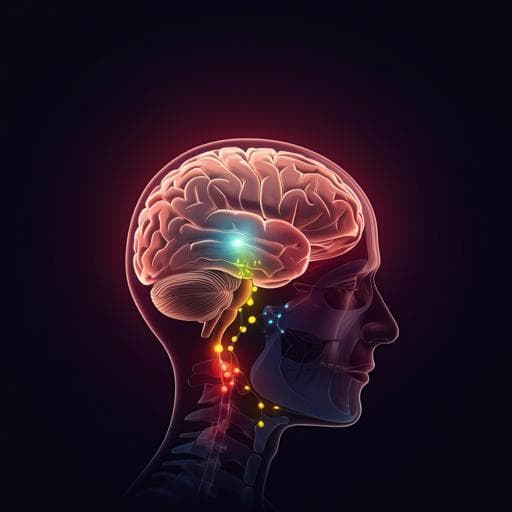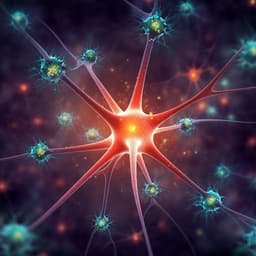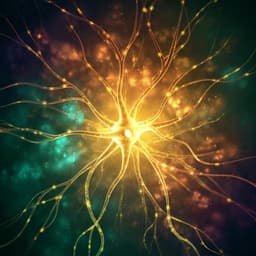
Medicine and Health
Stress-induced red nucleus attenuation induces anxiety-like behavior and lymph node CCL5 secretion
D. Shi, Y. Zhang, et al.
Explore groundbreaking research that reveals how stress influences immune responses through the brain-lymph node axis, led by researchers from the Shanghai Mental Health Center. Discover the connection between anxiety-like behavior and CCL5 levels, shedding light on the intricate interplay between the brain and immune system.
~3 min • Beginner • English
Introduction
Stress exposure can trigger or exacerbate anxiety disorders, potentially via inflammatory mechanisms. Immune signaling modulates neurobiological processes underlying anxiety and depression during stress. Traumatic events activate the HPA axis and immune system, releasing proinflammatory cytokines. Although cytokine/chemokine dysfunction has been implicated in stress-related disorders, the contribution of inflammation to their etiology remains unclear. It has been hypothesized that brain activity directly controls adaptive immune responses in lymphoid organs, but causal evidence linking stress-induced brain dysfunction to immune responses in lymphoid organs and anxiety is lacking. Prior studies implicated brain-spleen connections (e.g., CeA/PVN to splenic nerve) without behavioral effects after splenectomy. The precise neural loci and neuronal identities coupling stress and inflammation to anxiety have not been causally defined. This study investigates whether specific brain circuits regulate lymph node immune responses (notably CCL5) to drive stress-induced anxiety-like behavior, combining human assessments and mechanistic rat experiments.
Literature Review
Prior work shows stress-induced inflammatory responses are linked to psychiatric conditions including depression and anxiety. Neural-immune interactions include central nuclei (e.g., CeA, PVN) projecting to peripheral immune organs like the spleen, and sympathetic innervation of lymphoid tissues. Studies reported altered cytokine/chemokine profiles in anxiety, depression, PTSD, and chronic stress, with mixed findings for CCL5 across cohorts and conditions. The red nucleus (RN), classically motor-related, has been implicated in affective processing (reward anticipation, socioemotional scene processing) and pain/antinociception involving inflammatory mediators. However, upstream brain regions controlling lymph node immune activity and their causal roles in stress-induced anxiety remained undetermined.
Methodology
Human cohort: Psychiatrists exposed to frontline COVID-19 work in Wuhan (n=47 at 1 month; follow-ups at 6 and 12 months) and demographically matched controls (n=41 at baseline, 12-month follow-up) were assessed. Mental health questionnaires included PHQ-9, GAD-7, PCL-5, and SRQ-20 at acute phase (≈1 month post-stress), 6 months, and 12 months. Plasma cytokines/chemokines (MCP-1, IL-1β, IL-2, IL-4, IL-6, TGF-α, TNF-α, CCL5) plus BDNF and cortisol were measured by Luminex and ELISA. Resting-state fMRI (3T, SIEMENS Prisma) with preprocessing (DPABI/SPM12, motion exclusion, normalization, smoothing, bandpass filtering) examined seed-based functional connectivity using bilateral RN ROIs.
Rat studies: Adult male and female SD rats underwent acute restraint stress (2 h/day for 3 days). Additional models included early-life stress (maternal separation 2–4 h/day) and chronic unpredictable mild stress (5 weeks). Behavioral assays: open field test (OFT) and elevated plus maze (EPM). Serial tail-tip blood collections established 24-h profiles and time courses of serum CCL5 and corticosterone; ELISA quantified CCL5, corticosterone, and norepinephrine (NA).
CLN source and immune profiling: Multiple tissues screened for CCL5 induction post-stress identified cervical lymph nodes (CLNs). Bilateral cervical lymphadenectomy assessed behavioral effects and serum/CLN CCL5 responses. Flow cytometry quantified CD4+/CD8+ T cells and memory CD8+ T cells in blood and CLNs; intracellular CCL5 in CLN CD8+ T cells was measured.
Molecular analyses: CLN RNA-seq (HTSeq, Voom Limma, DAVID) assessed DEGs and pathway enrichment; qRT-PCR validated targets. Translation inhibition: anisomycin (7 mg/kg i.p.) administered before restraint stress, with immunohistochemistry to verify inhibition, and subsequent behavioral and CCL5 measurements.
Neuroanatomy and physiology: Retrograde transsynaptic tracing with PRV-RFP injected into CLNs identified upstream neurons. Immunostaining determined neurotransmitter phenotype (vGlut1 vs GAD67) of RN cells projecting to CLNs. Electrophysiology: whole-cell patch-clamp measured RN glutamatergic neuron excitability (firing frequency, rheobase, saturating current, voltage threshold, membrane potential) in control vs RS rats. Fiber photometry: AAV-CaMKIIα-GCaMP6s in RN with optic fiber recordings assessed Ca2+ dynamics during exploratory behavior in OFT/EPM.
Causal manipulations: Chemogenetics in RN glutamatergic neurons using AAV-CaMKII-hM4D(Gi)-mCherry (inhibition) and AAV-CaMKII-hM3D(Gq)-mCherry (activation), validated by slice patch-clamp; behavioral assays and CCL5 in serum/CLNs assessed after CNO. Cell ablation: AAV-CaMKII-Cre with AAV-EF1α-DIO-taCasp3-TEVP in RN to ablate glutamatergic neurons; validation via reduced vGlut1 staining and behavioral/CCL5 analyses. Systemic CCL5 neutralization: anti-CCL5 antibody i.p. following RN inhibition tested for anxiolytic rescue.
Circuit-level tests: M1→RN pathway targeted by injecting AAV1-hSyn-Cre into M1 and Cre-dependent constructs into RN (GCaMP6s for recording; hM4D(Gi) for inhibition of RN postsynaptic neurons receiving M1 input). Additional approach used retrograde Cre delivery from RN to M1 with DIO-hM4Di in M1. Patch-clamp verified DREADD efficacy in retrogradely labeled M1 neurons. Behavioral outcomes and CCL5 levels were measured. fMRI RN functional connectivity compared stressed vs controls with multiple-comparison correction.
Key Findings
Human cohort: In the acute phase (≈1 month post-stress), stressed individuals had higher SRQ-20 (p=0.001) and PCL-5 (p=0.019) scores; PHQ-9 and GAD-7 did not differ from controls. Plasma CCL5 (RANTES) was significantly elevated in stressed individuals vs controls (two-sided unpaired t test, p=0.0022), while cortisol was lower (p=0.0020). Other measured cytokines/chemokines (MCP-1, IL-1β, IL-2, IL-4, IL-6, TGF-α, TNF-α, BDNF) were not different. At 6 and 12 months, CCL5 decreased to control levels and cortisol recovered; PCL-5 normalized by 6 months, SRQ-20 by 12 months. CCL5 positively correlated with PCL-5, PHQ-9, and SRQ-20 across time.
Rats: Acute restraint stress (RS) induced anxiety-like behavior in males (reduced center time in OFT; reduced open-arm time in EPM) with no locomotor changes; females showed increased CCL5/corticosterone but no anxiety-like behavior. CCL5 rose sharply after first RS exposure in both sexes and remained elevated days after, without circadian oscillation; corticosterone displayed circadian rhythm. Early-life stress and CUMS also increased serum CCL5 and produced anxiety-like behaviors.
CLNs as CCL5 source: CCL5 robustly induced in CLNs after RS. Cervical lymphadenectomy did not alter locomotion but increased center time (anxiolytic trend) and abolished stress-induced serum CCL5 rise. RS increased frequencies and numbers of CLN CD8+ T cells and memory CD8+ T cells; CLN CD8+ T cells from RS rats showed higher intracellular CCL5.
Translational control: CLN RNA-seq (RS vs control) identified 4697 DEGs enriched in translation and immune process regulation; translation initiation factors increased and ribosomal genes decreased. eIF4E expression was upregulated. Anisomycin reduced CLN and serum CCL5 and alleviated anxiety-like behavior in RS rats, without affecting locomotion.
RN identification and dysfunction: PRV tracing from CLNs labeled neurons in RN and M1. In RN, ~89.72% of PRV+ neurons were vGlut1+ (glutamatergic). RS decreased RN glutamatergic neuron excitability (lower evoked firing; increased rheobase and saturating current; more hyperpolarized membrane potential; similar voltage threshold). Fiber photometry showed reduced Ca2+ signals in RN glutamatergic neurons during exploratory behavior in RS rats; higher RN activity associated with entering the OFT center (e.g., ΔF/F significantly lower in RS vs control, t-tests p<0.01).
Causality: Chemogenetic inhibition of RN glutamatergic neurons (hM4Di+CNO) increased anxiety-like behavior (reduced center time in OFT; reduced open-arm ratio in EPM) and elevated CCL5 in serum and CLNs; locomotion unaffected. RN glutamatergic neuron ablation (taCasp3) similarly increased anxiety and CCL5. Conversely, chemogenetic activation (hM3Dq+CNO) after RS reduced anxiety-like behavior and decreased serum/CLN CCL5. Systemic CCL5 neutralization reversed anxiety induced by RN inhibition.
Circuit mechanism: Inhibition of RN neurons postsynaptic to M1 inputs (M1 AAV1-hSyn-Cre; RN DIO-hM4Di) induced anxiety-like behavior and increased serum/CLN CCL5; locomotion unaffected. Retrograde Cre to M1 with DIO-hM4Di yielded similar behavioral and CCL5 increases. Fiber photometry targeting M1→RN postsynaptic RN neurons confirmed reduced Ca2+ signals during exploration after RS.
Sympathetic/NA link: Norepinephrine in CLNs increased with RS and with RN inhibition, suggesting sympathetic modulation of CLN responses.
Human fMRI: Stressed individuals exhibited decreased RN functional connectivity (left RN with left middle temporal and middle frontal gyri; right RN with bilateral middle temporal gyri), surviving multiple-comparisons corrections for temporal regions, consistent with RN dysfunction in stress.
Discussion
The findings provide causal evidence for a brain–lymph node axis wherein attenuation of RN glutamatergic neuron activity during stress drives CLN CCL5 synthesis and anxiety-like behavior. Clinically, elevated CCL5 and reduced cortisol in the acute phase of stress, along with decreased RN functional connectivity, suggest RN involvement in stress pathophysiology. Preclinically, RN glutamatergic neurons—largely identified as upstream of CLNs—exhibit reduced excitability and calcium activity after stress, and manipulating these neurons bidirectionally modulates both anxiety-like behavior and peripheral CCL5 levels. Lymphadenectomy and translation inhibition in CLNs mitigate stress-induced anxiety and CCL5, highlighting CLNs as key effectors. The M1→RN pathway contributes to this regulation, indicating a cortical influence on limbic-immune coupling. Increased CLN norepinephrine with stress and RN inhibition aligns with sympathetic modulation of adaptive immune cells (e.g., memory CD8+ T cells producing CCL5). Together, these results address the research question by identifying RN glutamatergic neurons and the M1→RN circuit as critical nodes linking stress to peripheral immune activation (CCL5) and anxiety, advancing mechanistic understanding and suggesting targets for intervention.
Conclusion
This study delineates a brain–lymph node axis in which stress-induced attenuation of RN glutamatergic neuron activity increases CCL5 production in cervical lymph nodes and promotes anxiety-like behavior. Key contributions include: (1) clinical evidence of transient CCL5 elevation and RN functional connectivity reductions following stress; (2) identification of CLNs as the primary source of stress-inducible CCL5; (3) causal demonstration that RN glutamatergic neurons and the M1→RN pathway regulate anxiety-like behavior and CCL5; and (4) evidence that translational upregulation in CLNs underlies CCL5 synthesis and that translation blockade or CCL5 neutralization mitigates anxiety. Future research should clarify the specific neural pathways and neurotransmitters mediating RN–CLN communication, resolve sex-specific differences in RN-dependent stress responses, and validate RN-targeted interventions and peripheral immune modulation strategies in larger human cohorts.
Limitations
Human blood sampling commenced one month after stress exposure, potentially missing acute-phase dynamics; cortisol reductions necessitated reliance on questionnaires to confirm elevated stress. The precise mechanisms of communication between RN and CLNs remain unresolved. Sex differences were observed—female rats showed elevated CCL5 without anxiety-like behavior under RS—requiring further study of RN function by sex. Controls did not experience novel nonstressful events, so novelty-related confounds cannot be excluded. fMRI analyses were limited by modest sample sizes, small effect sizes, midbrain signal noise, and multiple-comparison correction challenges, which warrant cautious interpretation and replication.
Related Publications
Explore these studies to deepen your understanding of the subject.







